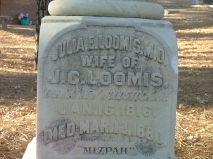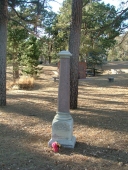Post written and copyrighted by Doris McCraw
We all learned the five W’s. Who, what, when, where and why and the greatest and most problematic of these is why. Why you may ask? As a historian you spend a lot of time researching people and events of the past. We can ascertain the who, what, when and where with ease. The whys are a bit stickier.
As an example, you know I am researching the early women doctors in the Pikes Peak Region. I am currently working on a book about the women doctors who practiced medicine prior to 1900 in Colorado Springs, Colorado who are buried in Evergreen Cemetery. In these two sentences I have answered the who and where. Who is women doctors practicing prior to 1900. The where, Colorado Springs, Colorado.
According to the records I can find one of the first to arrive was Julia E Loomis. It is possible she arrived as early as 1876 but definitely no later than 1878. In these two sentences I have answered who, when. The who, Julia E Loomis. The when, 1876 -1878.
You can find Julia’s family tree at: http://records.ancestry.com/Julia_E_Frizell_records.ashx?pid=33820338
Now comes the problematic why. Why did Julia become an MD? She may have practiced prior to going to the Cleveland Homeopathic College. She was born in 1816 and graduated in 1870. That made her age 54 at graduation.
More information about Cleveland College: http://ech.case.edu/cgi/article.pl?id=H4
After her graduation and her achieving and MD why did she come to Colorado Springs?
The biggest why I am dealing with now is why is she the only woman physician in Evergreen Cemetery that was practicing prior to 1900 to have an MD after her name? She was one of the first to arrive here, and the first to die.
To answer the above whys takes a small leap of faith and supposition. I am not comfortable with suppositions for they can be taken as fact, when in fact they are not. Why did she become and MD? The indication is that with the death of her daughter Julia Gertrude Loomis Taylor in 1864 at the age of 20-21, may have had something to do with it. Why did she come to Colorado Springs? At that time the city was becoming a mecca for health seekers. This may have played a part in that decision.
Now to the biggest why I am dealing with. Why is she the only early woman physician to have MD after her name? Did her husband have it put there? Perhaps it was her patients? Maybe it was the other women doctors, for there were two more from the same college who arrived between 1878 and 1880 who attended the same medical college. Why are none of the others given that same honor?
I may never get the concrete answers I am searching for, but it will not be from lack of trying. Still the problematic why will follow my research for many years to come. Until next time.
Follow my haiku post five days a week at:
http://fivesevenfivepage.blogspot.com
Below is the link to my non-fiction piece on the first state film commissioner in the United States included in this book.
“Film & Photography on the Front Range” can be purchased online at: http://www.amazon.com



I love when I finish a book and realize I’ve never had to ask “why” because that always tells me the writer did the necessary research and anticipated what their readers would want to know. Good luck in your research. It sounds very interesting.
LikeLike
I agree, when the whys are answered it allows everything else to fall in place. With fiction it gives more depth to the story and character. With non-fiction, like you say, if you can find the answer to the why the story becomes complete. Thanks for stopping by. Doris
LikeLike
That why is definitely the problem question, isn’t it, Doris? At some point you probably have to speculate, unless you can find letters or a diary or something. Good luck in your search. And don’t stop asking (I know you won’t).
LikeLike
Thank you for that. No I won’t! Still it can be a problem and one that some folks just gloss over. Appreciate you stopping by and writing a comment, it is so helpful. Doris
LikeLike
If anyone can find out the “Why” you can Doris! At times it is very difficult but occasionally you’ll find the answer you need. I think it’s especially necessary in non-fiction, as the truth is expected by readers. Good luck – I know you’ll find the answers you need!
LikeLike
Thank you Linda. To tell the truth is so important. But even in fiction, if you figure out the whys the story seems to tell itself. Doris
LikeLike
Maybe Julia was one of those women who had the guts to demand what was rightfully hers, an M.D. title. This was an interesting post.
LikeLike
I don’t know Abbie, but somehow that option wouldn’t surprise me. Thanks for stopping and commenting, it is appreciated. Doris
LikeLike
Doris, I always learn something when I read your blogs – thank you for that. But I’ve also come to respect and admire your persistence in the face of so many unknowns. Thank you for this great blog.
LikeLike
Erin, thank you. Your words mean a lot and the encouragement I get from you helps in these lonely and fun searches. Doris
LikeLike
Doris, as always you enlighten readers with your post. The question “why” is always that pesky one about life to which we may never fully know, even in history. But, it’s great to have detectives like you investigating to further enlighten us. Happy hunting!
LikeLike
Thank you Gayle. I hope I can do these women justice. I’ll give it my very best shot, they deserve it. Doris
LikeLike
What an interesting problem, doris. Was she just much more persistent… or what?
LikeLike
I don’t know Nancy, but I intend to find out if at all possible. I’ll let you all know when and if I get some answers. Thanks for your support. Doris
LikeLike
Lots of whys still to ponder. Sometimes supposition is all we can offer up. We try to get in their heads and analyze why they made particular decisions. I think you’re on to something about her daughter’s death in 1864 during the Civil War. How did her daughter die? Childbirth? TB? Yellow fever? Small pox? Cholera? Lots of killers back then, especially in a seaport city full of soldiers.
LikeLike
Mike, There are a lot of whys. I am one who doesn’t like to suppose, but may have to in order to. You are right about many killers. There have been some ‘hints’ that it might have been TB, but no conclusive evidence yet…but that won’t stop me from trying to find out. Thanks for the encouragement, it is very appreciated. Doris
LikeLike
Another comment post I made that has disappeared into cyberspace. Anyway, I always enjoy your posts. Love the history behind them. When I looked at the photos, I thought of gravestone rubbing. I’ve done that before and it was very interesting. Cher’ley
LikeLike
It is interesting. I don’t rub anymore for I was told it was not a good practice by someone who works in the cemetery. Still there are so many stories that can be ‘read’ from headstones. I confess I spend a lot of time at Evergreen (of course Helen is buried there) Thanks Cher’ley for your comments and support. Doris
LikeLike
Whoever was responsible for putting Julia’s M.D. on her gravestone, I’m glad they did it. Someone–even if it was Julia herself–thought it important enough to leave for posterity.
LikeLike
That was my thought Kathy. Research has shown that she was one of the earliest women doctors to Colorado Springs if not the first. Even though she was 64, and had only been here two to four years at her passing, she was the first to die and be buried here. In many ways, I think because she is the one who started me on this journey, I care for her the most. Doris
LikeLike